Tuning Forks
The tuning fork was invented in 1711 by John Shore, a trumpeter
and lutenist in the employ of the British Crown. He is supposed to have said,
at the beginning of a concert, "I do not have about me a pitch-pipe, but I
have what will do as well to tune by, a pitch fork."
For lecture room use the tuning fork is normally mounted
on a resonant box, open at one end and closed at the other, with a depth
of a quarter wavelength.
The two tuning forks at the right are are from Wittenburg
University in Ohio, and are marked with the name of James W. Queen of Philadelphia.
In the 1881 Queen catalogue, a mounted tuning fork sounding middle A cost
$8.50.
Other tuning forks are listed with the apparatus of
Rudolph
Koenig.
|

|
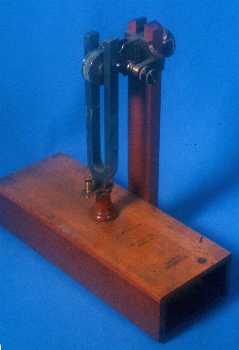
|
Even with the resonator, the sound from the tuning fork dies
away. Therefore, tuning forks may be driven magnetically using a solenoid
to attract one of the steel prongs of the fork. A make-and-break contact
in the energizing circuit provides the feedback to keep the oscillations
going. This example by Rudolph
Koenig from the College of Wooster in Ohio dates from 1900 and cost
44 marks. |
The electrically-driven tuning fork at the right was purchased
by the physics depaprtment of Hobart and William Smith Colleges in Geneva,
New York in the later 1920s from Max Kohl.
It produces a tone of 256 Hz (middle-C) and could be used as
a secondary frequency standard.
|
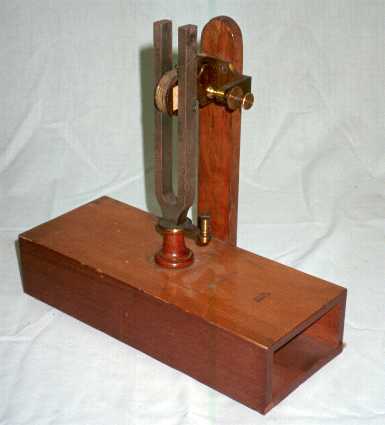
|
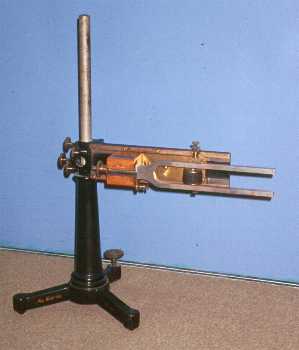
|
| Here are two more examples of driven tuning forks from
the College of Wooster. Both were made by Max Kohl, and were bought ca. 1900
to replace apparatus lost in a fire shortly before. |
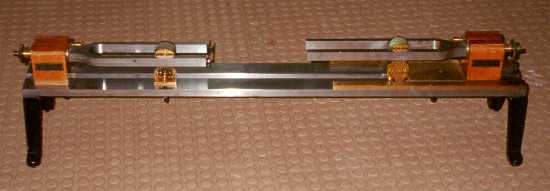
|
|
| This electrically driven tuning fork from Middlebury College
is a relatively rare example made by Morris E. Leeds of Philadelphia. In
use, the pointed piece of spring steel was attached to one of the tines,
and drew a sine wave on a smoked plate of glass being drawn under it.
Leeds joined Northrup about 1900 to form Leeds and Northrup,
a company which produced most of the precision electrical measurements apparatus
of my academic childhood in the 1950s. It was beautifully-made apparatus,
with perfect, smooth solder joints inside the boxes where no one ever saw
them.
|
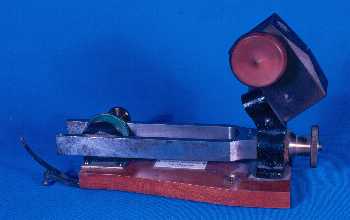
|
The two examples below have been used at Kenyon College to
drive one end of a taut string. One fork has been set to give a horizontal
polarization, and the other a vertical polarization. These forks, with their
handsome, lyre-shaped bases, were made by the L.E. Knott Apparatus Company
of Boston between 1895 and 1916. Colby College has a similar tuning fork,
with the driving mechanism missing.
The electrically-driven Max Kohl tuning fork below was originally
designed for Lissajous figure demonstrations, but at one time a screw eye
was added to allow it to drive a string. The 1900 Kolh catalogue notes that
it is a "Tuning Fork,
Ut(1) = 128 s.v. [i.e., 256 Hz], driven by electrical means, large pattern,
strongly made, with steel mirror and counter weight .. 90 Marks". (about $20).
It is in the Greenslade Collection.

This Central Scientific tuning fork, in the Greenslade Collection, spent
a long life as a string driver.
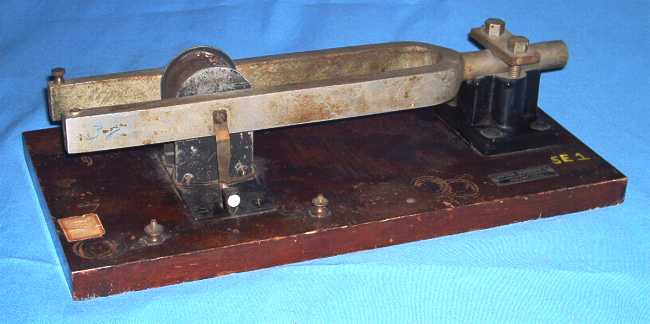
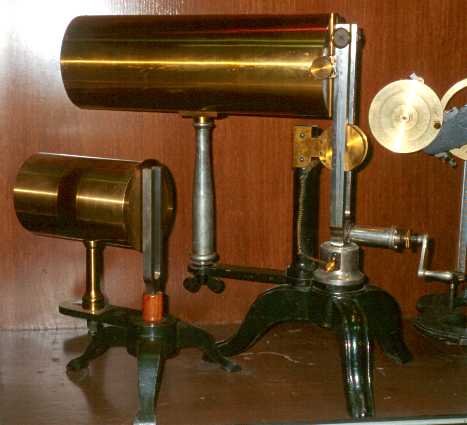
|
The pair of tuning forks at the left is in the apparatus collection
of Case Western Reserve University in Cleveleand, Ohio.
They were made by the firm of Max Kohl of Chemnitz, Germany,
and the larger one is electrically driven. The crank moves the driving coil
up and down to control the amplitude of the vibration.
|
Return
to Acoustics Home Page | Return
to Home Page